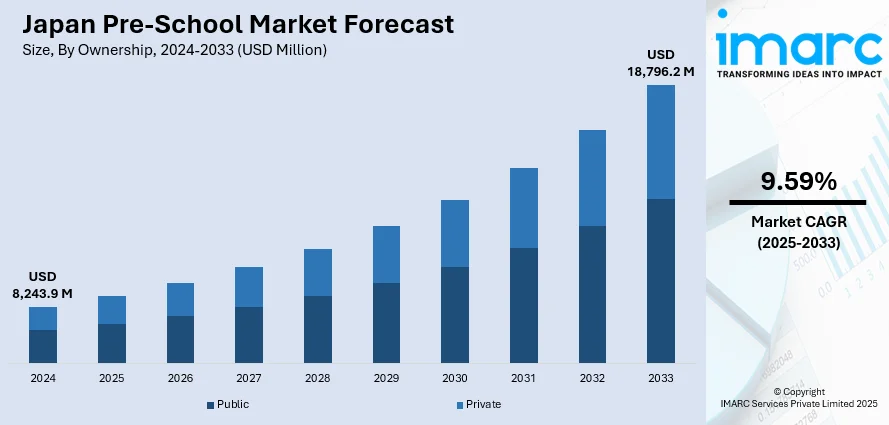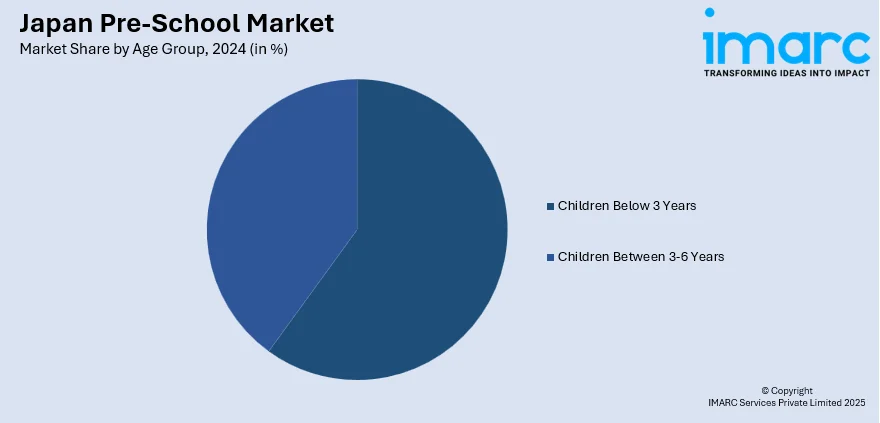
Japan Pre-School Market Size, Share, Trends and Forecast by Ownership, Age Group, and Region, 2025-2033
Japan Pre-School Market Overview:
The Japan pre-school market size reached USD 8,243.9 Million in 2024. Looking forward, IMARC Group expects the market to reach USD 18,796.2 Million by 2033, exhibiting a growth rate (CAGR) of 9.59% during 2025-2033. The market is growing due to increasing government initiatives, international exchange programs, and the rising demand for diverse early education experiences. These developments emphasize inclusivity, global learning, and high-quality pre-school access, driving the market towards broader and innovative educational options.
|
Report Attribute
|
Key Statistics
|
|---|---|
|
Base Year
|
2024
|
|
Forecast Years
|
2025-2033
|
|
Historical Years
|
2019-2024
|
| Market Size in 2024 | USD 8,243.9 Million |
| Market Forecast in 2033 | USD 18,796.2 Million |
| Market Growth Rate 2025-2033 | 9.59% |
Japan Pre-School Market Trends:
Expansion of International Preschool Programs
The Japanese preschool sector is experiencing a move towards greater international exposure by way of exchange programs, which present children with the ability to learn about varied educational systems as well as cultural environments. Parents are becoming increasingly aware of the advantages that result from global learning opportunities for their early years children. These programs offer a great opportunity for children to build a more well-rounded skill set early on, particularly in socialization, flexibility, and cross-cultural communication. This emerging trend mirrors the globalized aspect of contemporary education, where experiences outside the conventional classroom contribute extensively to a child's formation. In March 2025, the Japanese Preschool Exchange program attracted Hong Kong families, allowing children to attend Japanese preschools for one to three months. This initiative not only exposed the children to a new learning environment but also allowed them to interact with peers from different backgrounds, contributing to their cognitive and emotional development. The Japanese preschool curriculum, with a focus on autonomy, self-exploration, and communal integration, presented a unique model for Hong Kong children in contrast to the traditional offerings for many youngsters there. The initiative promotes increasing fascination with cross-cultural exchange as an avenue to widen the education process. As the success of such programs gains momentum, we can anticipate more nations developing similar programs that enable children to learn about various cultures and pedagogies, thus influencing pre-school market growth and supporting a globalized strategy for early childhood education. This trend will likely fuel a wider demand for international pre-schooling and increase the sharing of educational methods.

Government-Led Initiatives Driving Preschool Access
Government-initiated programs are at the forefront of redefining the preschool education landscape in Japan, with specific emphasis on increasing access to early childhood education. The programs aim to fill the gap for children who might not otherwise have access to quality pre-school education because of different socio-economic circumstances. By expanding access to high-quality, inclusive preschool programs, the government is building a sound foundation for later academic success and making sure that all children, regardless of their background, are well-equipped to handle the academic challenges that lie ahead. The focus on equal opportunity and wider outreach directly aligns with the continued growth supported by strong public policy and increasing societal recognition of early education's value. In September 2024, DoDEA Pacific launched Universal Prekindergarten (UPK) across 23 primary schools in Guam, Korea, Japan, and Okinawa, marking a significant step toward making preschool education accessible to all four-year-olds in these regions. This program was designed to give every child a chance to experience high-quality early childhood education programs, in accord with development standards, for preparation in future learning. The UPK program provides a comprehensive curriculum that emphasizes the children's whole development including social, emotional, cognitive, and physical growth. The success of the program has not only boosted preschool attendance but also created a standard for other areas of Japan and other countries to adopt, prompting governments to invest more heavily in early learning. As the trend continues, we should see further enhancements in the affordability and quality of preschool education, which will have beneficial impacts on the long-term learning and development of children.
Japan Pre-School Market Segmentation:
IMARC Group provides an analysis of the key trends in each segment of the market, along with forecasts at the country and regional level for 2025-2033. Our report has categorized the market based on ownership and age group.
Ownership Insights:
- Public
- Private
As per the pre-school market outlook, a detailed breakup and analysis of the market based on the ownership have also been provided in the report. This includes public and private.
Age Group Insights:

- Children Below 3 Years
- Children Between 3-6 Years
A detailed breakup and analysis of the market based on the age group have also been provided in the report. This includes children below 3 years and children between 3-6 years.
Regional Insights:
- Kanto Region
- Kansai/Kinki Region
- Central/ Chubu Region
- Kyushu-Okinawa Region
- Tohoku Region
- Chugoku Region
- Hokkaido Region
- Shikoku Region
The report has also provided a comprehensive analysis of all the major regional markets, which include Kanto Region, Kansai/Kinki Region, Central/ Chubu Region, Kyushu-Okinawa Region, Tohoku Region, Chugoku Region, Hokkaido Region, and Shikoku Region.
Competitive Landscape:
The market research report has also provided a comprehensive analysis of the competitive landscape. Competitive analysis such as market structure, key player positioning, top winning strategies, competitive dashboard, and company evaluation quadrant has been covered in the report. Also, detailed profiles of all major companies have been provided.
Japan Pre-School Market News:
- October 2024: Shiseido launched the "Preschool Exchange" program at its Kakegawa childcare facility, offering families immersive, nature-based preschool experiences. This initiative, supporting workcations and diverse work styles, boosted local engagement and contributed to the growth of family-friendly services, enhancing the preschool market in Japan.
- August 2024: Tokyo-based Wonderfy Inc. launched a Japanese-style kindergarten in Phnom Penh, Cambodia, addressing a teacher shortage. The school uses game-based lessons and offers Japanese language classes. This initiative expanded preschool education options in Cambodia, promoting cross-cultural learning and enhancing early childhood education standards.
Japan Pre-School Market Report Coverage:
| Report Features | Details |
|---|---|
| Base Year of the Analysis | 2024 |
| Historical Period | 2019-2024 |
| Forecast Period | 2025-2033 |
| Units | Million USD |
| Scope of the Report |
Exploration of Historical Trends and Market Outlook, Industry Catalysts and Challenges, Segment-Wise Historical and Future Market Assessment:
|
| Ownerships Covered | Public, Private |
| Age Groups Covered | Children Below 3 Years, Children Between 3-6 Years |
| Regions Covered | Kanto Region, Kansai/Kinki Region, Central/ Chubu Region, Kyushu-Okinawa Region, Tohoku Region, Chugoku Region, Hokkaido Region, Shikoku Region |
| Customization Scope | 10% Free Customization |
| Post-Sale Analyst Support | 10-12 Weeks |
| Delivery Format | PDF and Excel through Email (We can also provide the editable version of the report in PPT/Word format on special request) |
Key Questions Answered in This Report:
- How has the Japan pre-school market performed so far and how will it perform in the coming years?
- What is the breakup of the Japan pre-school market on the basis of ownership?
- What is the breakup of the Japan pre-school market on the basis of age group?
- What is the breakup of the Japan pre-school market on the basis of region?
- What are the various stages in the value chain of the Japan pre-school market?
- What are the key driving factors and challenges in the Japan pre-school?
- What is the structure of the Japan pre-school market and who are the key players?
- What is the degree of competition in the Japan pre-school market?
Key Benefits for Stakeholders:
- IMARC’s industry report offers a comprehensive quantitative analysis of various market segments, historical and current market trends, market forecasts, and dynamics of the Japan pre-school market from 2019-2033.
- The research report provides the latest information on the market drivers, challenges, and opportunities in the Japan pre-school market.
- Porter's five forces analysis assist stakeholders in assessing the impact of new entrants, competitive rivalry, supplier power, buyer power, and the threat of substitution. It helps stakeholders to analyze the level of competition within the Japan pre-school industry and its attractiveness.
- Competitive landscape allows stakeholders to understand their competitive environment and provides an insight into the current positions of key players in the market.
Need more help?
- Speak to our experienced analysts for insights on the current market scenarios.
- Include additional segments and countries to customize the report as per your requirement.
- Gain an unparalleled competitive advantage in your domain by understanding how to utilize the report and positively impacting your operations and revenue.
- For further assistance, please connect with our analysts.
 Request Customization
Request Customization
 Speak to an Analyst
Speak to an Analyst
 Request Brochure
Request Brochure
 Inquire Before Buying
Inquire Before Buying




.webp)




.webp)












